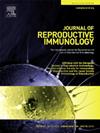Targeting the lncRNA GAS5/TLR4/NLRP3 signaling cascade inhibits endometrial stromal cell pyroptosis and prevents the progression of intrauterine adhesions
IF 2.9
3区 医学
Q3 IMMUNOLOGY
引用次数: 0
Abstract
Intrauterine adhesion (IUA) poses a serious threat to women's health, and its specific pathogenesis has not yet been elucidated. Our study found through high-throughput sequencing that differentially expressed genes of the endometrial tissues from healthy individuals or IUA patients were enriched in the toll-like receptor (TLR), nuclear factor-kappa B (NF-kB), and nucleotide-binding oligomerization domain-like receptor (NLR) signaling pathways. Meanwhile, we observed that compared to the controls, long non-coding RNA (lncRNA) growth arrest-specific transcripts 5 (GAS5) was significantly upregulated in the endometrial tissue of IUA patients and scratching/lipopolysaccharide (LPS)-induced IUA model mice. Subsequently, results from the functional verification assay, including hematoxylin-eosin staining, enzyme-linked immunosorbent assay, and western blot, showed that knockdown of GAS5 improved endometrial injury and uterine adhesions, decreased the levels of TIMP1, α-SMA, Vimentin, and COL1A1, but elevated MMP9 level to reduce excessive accumulation of extracellular matrix (ECM), and inhibited the expression of NLRP3, cleaved caspase-1, GSDMD, and nuclear p65 to ameliorate pyroptosis in IUA model mice. As confirmed by bioinformatics analysis and dual luciferase reporter gene system, GAS5 sponged microRNA (miR)-205–5p to upregulate TLR4, further activating the NF-kB and NLRP3 signaling in endometrial stromal cells (ESCs). The in vitro functional recovery experiments suggested that GAS5 knockdown alleviated LPS-induced activation of the NF-kB and NLRP3 signaling, pyroptotic cell death, and ECM deposition in ESCs, which was counteracted by overexpressing TLR4 and NLRP3. In a word, our study proved that targeting the GAS5/TLR4/NLRP3 signaling cascade inhibits ESCs pyroptosis and prevents the progression of IUA, providing promising therapeutic strategies for IUA disease.
靶向lncRNA GAS5/TLR4/NLRP3信号级联抑制子宫内膜间质细胞焦亡,阻止宫内粘连进展
宫内粘连(IUA)严重威胁妇女健康,其具体发病机制尚未阐明。我们的研究通过高通量测序发现,健康个体或IUA患者子宫内膜组织的差异表达基因在toll样受体(TLR)、核因子κ B (NF-kB)和核苷酸结合寡聚结构域样受体(NLR)信号通路中富集。同时,我们观察到,与对照组相比,长链非编码RNA (lncRNA)生长阻滞特异性转录本5 (GAS5)在IUA患者和抓挠/脂多糖(LPS)诱导的IUA模型小鼠子宫内膜组织中显著上调。随后,苏木精-伊红染色、酶联免疫吸附和western blot等功能验证实验结果显示,敲低GAS5可改善子宫内膜损伤和子宫粘连,降低TIMP1、α-SMA、Vimentin和COL1A1的水平,但提高MMP9水平以减少细胞外基质(ECM)的过度积累,抑制NLRP3、cleaved caspase-1、GSDMD、和核p65改善IUA模型小鼠的焦亡。生物信息学分析和双荧光素酶报告基因系统证实,GAS5海绵microRNA (miR) -205-5p上调TLR4,进一步激活子宫内膜基质细胞(ESCs)的NF-kB和NLRP3信号。体外功能恢复实验表明,GAS5敲低可减轻lps诱导的内皮细胞NF-kB和NLRP3信号的激活、焦亡细胞死亡和ECM沉积,而过表达TLR4和NLRP3可抵消这些作用。总之,我们的研究证明,靶向GAS5/TLR4/NLRP3信号级联抑制ESCs焦亡,阻止IUA的进展,为IUA疾病的治疗提供了有希望的策略。
本文章由计算机程序翻译,如有差异,请以英文原文为准。
求助全文
约1分钟内获得全文
求助全文
来源期刊
CiteScore
6.30
自引率
5.90%
发文量
162
审稿时长
10.6 weeks
期刊介绍:
Affiliated with the European Society of Reproductive Immunology and with the International Society for Immunology of Reproduction
The aim of the Journal of Reproductive Immunology is to provide the critical forum for the dissemination of results from high quality research in all aspects of experimental, animal and clinical reproductive immunobiology.
This encompasses normal and pathological processes of:
* Male and Female Reproductive Tracts
* Gametogenesis and Embryogenesis
* Implantation and Placental Development
* Gestation and Parturition
* Mammary Gland and Lactation.

 求助内容:
求助内容: 应助结果提醒方式:
应助结果提醒方式:


